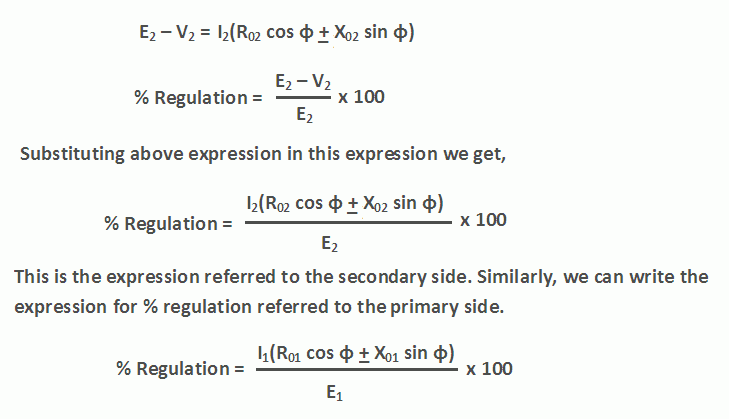Output voltage of a transformer decreases as we put load on it and the voltage will fluctuate with the fluctuation in the load. These unwanted fluctuations in the output voltage cause many problems.
This happens due to voltage drop in its winding. When we measure the output voltage of a transformer, without loading it, we get maximum output voltage because in this case no current is flowing in the secondary winding and a very small current is flowing (magnetizing current) in the primary winding. Due to very small current in the windings, very small voltage drops and we get maximum output voltage.
But when we connect a load, load current flows in the secondary winding and transformer draws more current from the source. This increased flow of current causes more voltage drop in the windings. As a result, output voltage of the transformer decreases.
Voltage Regulation of Transformer
The voltage regulation of transformer is defined as the change in secondary terminal voltage (V2) from no-load to full load at constant primary voltage and temperature. It is expressed as a percentage of the secondary no-load voltage.
Mathematically, % Regulation of transformer = (E2 – V2) x 100 / E2
No-load voltage: The secondary terminal voltage of transformer when no load is connected to the transformer is known as the no-load voltage of the transformer. At no load, the secondary terminal voltage will be equal to induced EMF in the secondary winding.
So, no-load voltage = E2 volts
Full load voltage: It is the secondary terminal voltage of transformer when a rated load is connected to the transformer. We will denote it by V2.
When a transformer is loaded a voltage drop in primary and secondary impedances of transformer takes place. As the load current increases, this voltage drop will increase. This will reduce the secondary terminal voltage V2. The ideal value of voltage regulation of transformer is 0%.
Voltage Regulation of Transformer | Formula
The approximate expression for the total voltage drop (E2 – V2) in a transformer as referred to secondary is given by

Calculate Voltage Regulation of Transformer
Example: A 100 kVA transformer has 400 turns on the primary and 80 turns on the secondary. The primary and secondary resistances are 0.3 Ω and 0.01 Ω respectively and the corresponding leakage reactances are 1.1 and 0.035 Ω respectively. The supply voltage is 2200 V. Calculate:
- equivalent impedance referred to primary and,
- the voltage regulation and the secondary terminal voltage for full load having a power factor of 0.8 leading.
Solution: K = 80/400 = 1/5,
R1 = 0.3 Ω,
R01 = R1 + R2/K2 = 0.3 + 0.01/(1/5)2 = 0.55 Ω
X01 = X1 + X2/K2 = 1.1 + 0.035/(1/5)2 = 1.975 Ω
Z01 = 0.55 + j 1.975 = 2.05 ∠74.44o
Z02 = K2Z01 = (1/5)2 (0.55 + j 1.975) = (0.022 + j 0.079)
No-load secondary voltage = KV1 = (1/5) × 2200 = 440 V,
I2 = 10 × 103/440 = 227.3 A
Full-load voltage drop as referred to secondary
= I2 (R02 cos φ − X02 sin φ)
= 227.3 (0.022 × 0.8 − 0.079 × 0.6 ) = − 6.77 V
% regn. = − 6.77 × 100/440 = − 1.54
Secondary terminal voltage on load = 440 − (− 6.77) = 446.77 V
Thanks for reading about ‘voltage regulation of transformer’.
Transformer | All Posts
- Ideal Transformer
- Construction of Three Phase Transformer
- Types of Transformers
- Equivalent Resistance and Reactance of Transformer
- Equivalent Circuit of Single Phase Transformer
- Power Loss in a Transformer
- Open Circuit Test of Single Phase Transformer
- Short Circuit Test on Single Phase Transformer
- Transformer Efficiency
- Regulation of Transformer
- Autotransformer
- Instrument Transformers
- Polarity of Transformer Windings
- Significance of Vector Group of Transformer
- Buchholz Relay Construction | Working
- Why current transformer secondary should not be opened
- Dielectric Strength Test of Transformer Oil
- Transformer Moisture Removal Process
© https://yourelectricalguide.com/ voltage regulation formula.